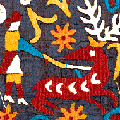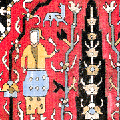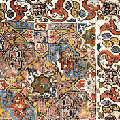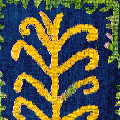Textile Art of the Caucasus
A selection of
Caucasian embroideries from the 17th to the 19th centuries
Exhibition organised by The Textile Gallery
|
INTRODUCTION Following the success of the exhibition Turkish Rugs and Old Master Paintings, The Textile Gallery has embarked upon a programme of thematic exhibitions to be shown in a number of different venues in Europe and America. All the works presented are offered for sale, and it is hoped that the variety and nature of the exhibits will provide a broader perspective of the art of particular regions or cultures and will stimulate the interest of new collectors in these beautiful works of textile art. Textile Art of the Caucasus, presented at Rippon Boswell, Wiesbaden, Germany, in October and November 1996, was devoted principally to the silk embroideries of the region - unsigned works of art created in the 17th, 18th and early 19th centuries. As far as we know, there had never previously been an exhibition specifically devoted to Caucasian embroideries and no book has been produced to date on this subject.Textile Art of the Caucasus was the first exhibition to bring together silk embroideries from several areas of the Caucasus, providing the opportunity to compare their various artistic and technical styles. Several of the textiles employ the same patterns that can be seen on early Caucasian rugs, and for this reason we included a small group of the latter. In 1993, our sister company Textile & Art Publications published a book on Kaitag embroideries - Kaitag Textile Art from Daghestan, by Robert Chenciner - but these come from one small region and, although very beautiful, are not fully representative of the great variety of embroidered panels that were created throughout the Transcaucasus region. |
CAUCASIAN EMBROIDERIES
|
|
The most beautiful examples of Caucasian embroidery that survive are scattered in museum and private collections throughout the world, and illustrations of them can generally only be found in a number of rare books on oriental rugs; it is hoped that one day the rich variety of Caucasian embroidery may be brought together in a single publication. In the meantime, over the past twenty-eight years, we have been most fortunate to have had a number of outstanding examples pass through our hands; these, combined with those noted in public and private collections and those published in the literature, have given us the basis for a small archive of illustrations for study and research. Based upon this, for the purposes of our own studies and identification, we have chosen to divide Caucasian embroideries into five groups. This has been done principally on the basis of style, but also taking technique into consideration. | |
 The Hunt Probably Kaitag region, south-west Daghestan 17th century 46 x 30 cm, silk embroidery on silk (detail) |
Group
1 |
|
 Cypress Tree with Figures Possibly Shirvan region, east Caucasus 17th century 108 x 102 cm, silk embroidery on cotton (detail) |
Group
2 |
|
 Stars and Octagons Possibly Karabagh region, south-west Caucasus, circa 1700 72 x 84 cm, silk embroidery on cotton (detail) |
Group
3 |
|
 Cartouches and Stars Probably Azerbaijan, south Caucasus early 18th century 46 x 97 cm, silk embroidery on cotton (detail) |
Group
4 |
|
 Tree of Life Kaitag region, south-west Daghestan 18th century 67 x 114 cm, silk embroidery on cotton (detail) |
Group
5 While the principal group of Kaitag embroideries follow a very clear style with a defined pattern repertoire, others are clearly inspired by design traditions from neighbouring regions (ref. 16601 - detail left ). There are examples resembling embroideries from Karabagh (ref. 16687), Azerbaijan and Persia (ref. 17397 - detail at top of page). There is a category of Kaitag embroideries resembling Ottoman textiles from the 16th and 17th centuries - both the courtly velvets and brocade silks from Bursa (ref.17589) and the domestic embroideries of Thrace and Epirus. Almost all Kaitag embroideries are worked on a foundation cloth of coarsely woven cotton in a open-faced plain weave (often called 'tabby'). This foundation cloth is usually composed of smaller sections pieced together, often dyed. Sometimes these sections are of different colours, which can also contribute to the overall effectiveness of the design (ref. 16610). A few examples, usually in the Ottoman design style, are embroidered with a layer of woven silk above the cotton foundation. |
|
|
|
The dating of Caucasian embroideries is fraught with difficulties, in spite of the few known dated examples, and authors have made various speculations. Often these have been based upon the knotted pile carpet designs to which several of the embroideries relate - yet there is no agreement on the dating of the various carpet groups. The dates proposed appear, for the most part, to be based upon limited research. It is evident that the Kaitag embroideries contain a variety of design elements of great antiquity, of both foreign and ancient local origin, but the continuity of design tradition makes it very difficult to date the earlier embroideries; only one dated example is known (detail left). It would be misleading to attempt to ascribe dates to the embroideries on the basis of their archaic designs alone, since such designs have survived until recent times in other media in Daghestan. |